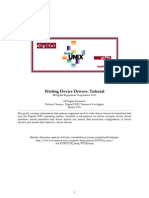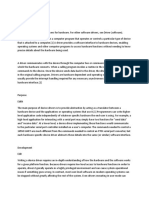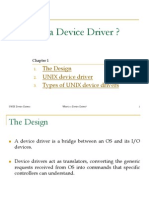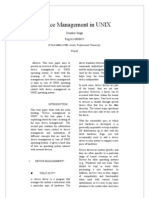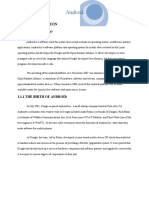Chapter 2. Understanding Device Drivers: 2.2 Classification of Drivers According To Functionality
Chapter 2. Understanding Device Drivers: 2.2 Classification of Drivers According To Functionality
Uploaded by
Jeffer MwangiCopyright:
Available Formats
Chapter 2. Understanding Device Drivers: 2.2 Classification of Drivers According To Functionality
Chapter 2. Understanding Device Drivers: 2.2 Classification of Drivers According To Functionality
Uploaded by
Jeffer MwangiOriginal Description:
Original Title
Copyright
Available Formats
Share this document
Did you find this document useful?
Is this content inappropriate?
Copyright:
Available Formats
Chapter 2. Understanding Device Drivers: 2.2 Classification of Drivers According To Functionality
Chapter 2. Understanding Device Drivers: 2.2 Classification of Drivers According To Functionality
Uploaded by
Jeffer MwangiCopyright:
Available Formats
Chapter 2.
Understanding Device Drivers
This chapter provides you with a general introduction to device drivers and takes you through the
structural elements of a device driver.
2.1 Device Driver Overview
Device drivers are the software segments that provide an interface between the operating system
and the specific hardware devices such as terminals, disks, tape drives, video cards and network
media. The device driver brings the device into and out of service, sets hardware parameters in
the device, transmits data from the kernel to the device, receives data from the device and passes
it back to the kernel, and handles device errors.
A driver acts like a translator between the device and programs that use the device. Each device
has its own set of specialized commands that only its driver knows. In contrast, most programs
access devices by using generic commands. The driver, therefore, accepts generic commands
from a program and then translates them into specialized commands for the device.
2.2 Classification of Drivers According to
Functionality
There are numerous driver types, differing in their functionality. This subsection briefly
describes three of the most common driver types.
2.2.1 Monolithic Drivers
Monolithic drivers are device drivers that embody all the functionality needed to support a
hardware device. A monolithic driver is accessed by one or more user applications, and directly
drives a hardware device. The driver communicates with the application through I/O control
commands (IOCTLs) and drives the hardware using calls to the different WDK, ETK, DDI/DKI
functions.
Figure 2.1 Monolithic Drivers
Monolithic drivers are supported in all operating systems including all Windows platforms and
all Unix platforms.
2.2.2 Layered Drivers
Layered drivers are device drivers that are part of a stack of device drivers that together process
an I/O request. An example of a layered driver is a driver that intercepts calls to the disk and
encrypts/decrypts all data being transferred to/from the disk. In this example, a driver would be
hooked on to the top of the existing driver and would only do the encryption/decryption.
Layered drivers are sometimes also known as filter drivers, and are supported in all operating
systems including all Windows platforms and all Unix platforms.
Figure 2.2 Layered Drivers
2.2.3 Miniport Drivers
A Miniport driver is an add-on to a class driver that supports miniport drivers. It is used so the
miniport driver does not have to implement all of the functions required of a driver for that class.
The class driver provides the basic class functionality for the miniport driver.
A class driver is a driver that supports a group of devices of common functionality, such as all
HID devices or all network devices.
Miniport drivers are also called miniclass drivers or minidrivers, and are supported in the
Windows NT (2000) family, namely Windows 7 / Vista / Server 2008 / Server 2003 / XP / 2000 /
NT 4.0.
Figure 2.3 Miniport Drivers
Windows 7/Vista/Server 2008/Server 2003/XP/2000/NT 4.0 provide several driver classes
(called ports) that handle the common functionality of their class. It is then up to the user to add
only the functionality that has to do with the inner workings of the specific hardware. The NDIS
miniport driver is one example of such a driver. The NDIS miniport framework is used to create
network drivers that hook up to NT's communication stacks and is therefore accessible to
common communication calls used by applications. The Windows NT kernel provides drivers
for the various communication stacks and other code that is common to communication cards.
Due to the NDIS framework, the network card developer does not have to write all of this code,
only the code that is specific to the network card he is developing.
You might also like
- Linux Wifi Developer GuideDocument287 pagesLinux Wifi Developer GuideKuldeep Kushwaha100% (6)
- Meat Log Mountain Full Version Free Updated PDFDocument3 pagesMeat Log Mountain Full Version Free Updated PDFGiovanniNo ratings yet
- FirmwareDocument5 pagesFirmwarehariNo ratings yet
- Writing Device Drivers - TutorialDocument12 pagesWriting Device Drivers - Tutorialrakhamma100% (1)
- Drivers WikiDocument4 pagesDrivers WikiLucero HernandezNo ratings yet
- A Report On Device Drivers: Submitted By: Rakesh Krishnan Mtech DEAC 100915020Document6 pagesA Report On Device Drivers: Submitted By: Rakesh Krishnan Mtech DEAC 100915020rak.cea4098No ratings yet
- What Is Device DriverDocument8 pagesWhat Is Device Driverapi-26349602No ratings yet
- Device DriversDocument5 pagesDevice DriversnazruNo ratings yet
- Device Driver: PurposeDocument4 pagesDevice Driver: PurposeKarthik NarayananNo ratings yet
- Device Driver-WPS OfficeDocument7 pagesDevice Driver-WPS OfficeAlbert Magno CaoileNo ratings yet
- MCS-022 Operating System Concepts andDocument29 pagesMCS-022 Operating System Concepts andSumit RanjanNo ratings yet
- Unix Device DriversDocument22 pagesUnix Device DriversSwetang KhatriNo ratings yet
- 0 X 01 The BasicsDocument6 pages0 X 01 The BasicsphpfluestererNo ratings yet
- Chapter 6 - Developing Device DriversDocument70 pagesChapter 6 - Developing Device DriversSunil PaiNo ratings yet
- Window Driver Model WDMDocument32 pagesWindow Driver Model WDMHavu HaNo ratings yet
- Q:-Difference Between The Software and Hardware?Document6 pagesQ:-Difference Between The Software and Hardware?Umair AzharNo ratings yet
- Anatomy of Device DriversDocument15 pagesAnatomy of Device Driversmerin50% (2)
- Drives For Girl FriendDocument7 pagesDrives For Girl Friendravikiranzz12345No ratings yet
- Block2 - Introduction - To - Operating SystemsDocument44 pagesBlock2 - Introduction - To - Operating SystemsAlbert NgiruwonsangaNo ratings yet
- Linux Device DriversDocument26 pagesLinux Device Driversjackel.intouch481100% (1)
- User Mode I. System Support Processes: de Leon - Dolliente - Gayeta - Rondilla It201 - Platform Technology - TPDocument5 pagesUser Mode I. System Support Processes: de Leon - Dolliente - Gayeta - Rondilla It201 - Platform Technology - TPCariza DollienteNo ratings yet
- User Mode I. System Support Processes: de Leon - Dolliente - Gayeta - Rondilla It201 - Platform Technology - TPDocument6 pagesUser Mode I. System Support Processes: de Leon - Dolliente - Gayeta - Rondilla It201 - Platform Technology - TPCariza DollienteNo ratings yet
- Device Driver: Operating SystemsDocument10 pagesDevice Driver: Operating SystemsvinranNo ratings yet
- Mobile OS Architectures Security ModelsDocument114 pagesMobile OS Architectures Security Modelses169371No ratings yet
- Presentation by Shubham MalikDocument54 pagesPresentation by Shubham Malikshubhammalik94167No ratings yet
- OS ReportDocument19 pagesOS ReportsadiyaNo ratings yet
- Independent Study Seminar On Android: Made By: Siddharth 09ITMG1086CSEDocument26 pagesIndependent Study Seminar On Android: Made By: Siddharth 09ITMG1086CSEsetia_tarikNo ratings yet
- Device Management in UnixDocument5 pagesDevice Management in Unixdiwaker100% (1)
- Android SummaryDocument5 pagesAndroid SummaryMadhava Ram ParanandiNo ratings yet
- Android Operating SystemDocument18 pagesAndroid Operating SystemManu JhaNo ratings yet
- Mad UtDocument5 pagesMad UtAakash ChaudhariNo ratings yet
- Hacking Windows Phone OSDocument7 pagesHacking Windows Phone OSKaren GarzaNo ratings yet
- My Lecture15 DeviceDriversDocument37 pagesMy Lecture15 DeviceDriversPooja SNo ratings yet
- Operating SystemsDocument12 pagesOperating SystemsPalash ParmarNo ratings yet
- My Lecture7 DeviceDriversDocument36 pagesMy Lecture7 DeviceDriversbondultimateNo ratings yet
- 1.1 What Is ANDROID?Document24 pages1.1 What Is ANDROID?Geetha Reddy MNo ratings yet
- Android Unit-1Document11 pagesAndroid Unit-1Sirisha AnnamrajuNo ratings yet
- DCS216 Compiled Note-1Document75 pagesDCS216 Compiled Note-1Hafeex ShuaibuNo ratings yet
- Unit 2Document11 pagesUnit 2Leah GabrielNo ratings yet
- Ghadeer Haider - Windows OS ArchitectureDocument13 pagesGhadeer Haider - Windows OS ArchitectureGhadeer HaiderNo ratings yet
- Android: 1.1. The Birth of AndroidDocument24 pagesAndroid: 1.1. The Birth of AndroidKonda RaveendrakumarNo ratings yet
- Installation: 1.1 Downloading and Installing DicodessDocument10 pagesInstallation: 1.1 Downloading and Installing DicodessZahoor Ahmad KhanNo ratings yet
- An 220 FTDI Drivers Installation Guide For LinuxDocument11 pagesAn 220 FTDI Drivers Installation Guide For Linuxasic hienNo ratings yet
- Chpt9a Supporting IO DevicesDocument19 pagesChpt9a Supporting IO DevicesPradeep TiwariNo ratings yet
- Software - Hugo Johnson - 001140Document3 pagesSoftware - Hugo Johnson - 001140latoya andersonNo ratings yet
- Documentatie EOC-EMC V1 For CandidatesDocument13 pagesDocumentatie EOC-EMC V1 For CandidatesDonea PetrinaNo ratings yet
- Android InternalsDocument6 pagesAndroid InternalsQai UlquiorraNo ratings yet
- Principles of Operating Systems and Its Applications1Document11 pagesPrinciples of Operating Systems and Its Applications1Nicoco LocoNo ratings yet
- Mad Q5, Q8, Q9Document3 pagesMad Q5, Q8, Q9Ved SawantNo ratings yet
- Android ArchitectureDocument3 pagesAndroid ArchitectureRajesh KannaNo ratings yet
- SYSTEM SOFTWARE-CC100 Group 5Document21 pagesSYSTEM SOFTWARE-CC100 Group 5PRINCE DANIEL LUCIANONo ratings yet
- Question BankDocument42 pagesQuestion Bank02 - CM Ankita AdamNo ratings yet
- 2Document4 pages2lgugunashviliNo ratings yet
- Architecture of Windows NTDocument8 pagesArchitecture of Windows NTKaran BakshiNo ratings yet
- Software Suite: Revolutionizing Computer Vision with the Ultimate Software SuiteFrom EverandSoftware Suite: Revolutionizing Computer Vision with the Ultimate Software SuiteNo ratings yet
- Android Programming For Beginners: The Ultimate Android App Developer's GuideFrom EverandAndroid Programming For Beginners: The Ultimate Android App Developer's GuideNo ratings yet
- Docker: The Complete Guide to the Most Widely Used Virtualization Technology. Create Containers and Deploy them to Production Safely and Securely.: Docker & Kubernetes, #1From EverandDocker: The Complete Guide to the Most Widely Used Virtualization Technology. Create Containers and Deploy them to Production Safely and Securely.: Docker & Kubernetes, #1No ratings yet
- Linux Essentials - A Beginner's Guide To Linux Operating SystemFrom EverandLinux Essentials - A Beginner's Guide To Linux Operating SystemRating: 3 out of 5 stars3/5 (1)
- Linux: A Comprehensive Guide to Linux Operating System and Command LineFrom EverandLinux: A Comprehensive Guide to Linux Operating System and Command LineNo ratings yet
- Operating System BasicsDocument13 pagesOperating System BasicsJeffer MwangiNo ratings yet
- What Is SpoolingDocument3 pagesWhat Is SpoolingJeffer MwangiNo ratings yet
- Year Project A Project B Net Profit Value Net Profit ValueDocument1 pageYear Project A Project B Net Profit Value Net Profit ValueJeffer MwangiNo ratings yet
- Selection Sort Algorithm in ProgrammingDocument6 pagesSelection Sort Algorithm in ProgrammingJeffer MwangiNo ratings yet
- SPSS Independent Samples T TestDocument72 pagesSPSS Independent Samples T TestJeffer MwangiNo ratings yet
- File Handling in C LanguageDocument45 pagesFile Handling in C LanguageJeffer MwangiNo ratings yet
- Principal Components AnalysisDocument13 pagesPrincipal Components AnalysisJeffer MwangiNo ratings yet
- Diagram of Four Phases of Business Cycle: DefinitionDocument7 pagesDiagram of Four Phases of Business Cycle: DefinitionJeffer MwangiNo ratings yet
- Acronis Snap Deploy v4.0Document5 pagesAcronis Snap Deploy v4.0Yonny Javier VivasNo ratings yet
- RDX Manager 0.1.0.40 Release NotesDocument3 pagesRDX Manager 0.1.0.40 Release NotesBoopala KrishnanNo ratings yet
- Easy Guide To Make Hiren's Bootable USB Flash Drive - Learn Basics of Linux OSDocument8 pagesEasy Guide To Make Hiren's Bootable USB Flash Drive - Learn Basics of Linux OSborlix100% (1)
- Dllmain - CPP: Defines The Entry Point For The DLL ApplicationDocument2 pagesDllmain - CPP: Defines The Entry Point For The DLL ApplicationChocolatebuonNo ratings yet
- SAT 23T USE Utility Tool For POS Instruction - English - Rev.1.0Document27 pagesSAT 23T USE Utility Tool For POS Instruction - English - Rev.1.0Jhon EcheverriNo ratings yet
- EasyScopeX Install GuideDocument12 pagesEasyScopeX Install GuideviyikitoNo ratings yet
- RD-64 System Update Procedure PDFDocument3 pagesRD-64 System Update Procedure PDFBruno AdamNo ratings yet
- Windows HistoryDocument1 pageWindows Historynono_chNo ratings yet
- Translations in WebDynpro For ABAPDocument10 pagesTranslations in WebDynpro For ABAPavukushirishNo ratings yet
- RPCOMDocument8 pagesRPCOMbaticbbNo ratings yet
- Fif-12 Om Eng Eaj23x102Document13 pagesFif-12 Om Eng Eaj23x102Schefer FabianNo ratings yet
- Update Galileos System Software To MS7 - Sirona SupportDocument4 pagesUpdate Galileos System Software To MS7 - Sirona SupportdhfhdtNo ratings yet
- Proe InstallationDocument3 pagesProe InstallationCadcam CentreNo ratings yet
- Report On Android WorkshopDocument7 pagesReport On Android WorkshopabhishekNo ratings yet
- Fortran+ AbaqusDocument4 pagesFortran+ Abaquschumma123No ratings yet
- 2D-Exercise: Design & Developed by Indo-Danish Tool Room, JamshedpurDocument23 pages2D-Exercise: Design & Developed by Indo-Danish Tool Room, JamshedpurShubham GuptaNo ratings yet
- Fan TelDocument2 pagesFan TelFabiánHurtadoNo ratings yet
- Guide UsdEditor enDocument6 pagesGuide UsdEditor enslimamriNo ratings yet
- Android AssignmentDocument3 pagesAndroid AssignmentjobanNo ratings yet
- How To Create A Local Debian/Ubuntu Mirror With Apt-Mirror - Page 2Document7 pagesHow To Create A Local Debian/Ubuntu Mirror With Apt-Mirror - Page 2har yadiNo ratings yet
- ReadmeengDocument3 pagesReadmeengIlanildo DiasNo ratings yet
- Windows and Office Activator Using HWID - Ohook - KMS38 - Online KMS Activation Methods (Link. Github - comMassgravelMicrosoft-Activation-Scripts)Document3 pagesWindows and Office Activator Using HWID - Ohook - KMS38 - Online KMS Activation Methods (Link. Github - comMassgravelMicrosoft-Activation-Scripts)Sajjad KhanNo ratings yet
- Server MigrationDocument16 pagesServer MigrationKrishanThiseraNo ratings yet
- External Command in 10 Steps For Revit 2015Document2 pagesExternal Command in 10 Steps For Revit 2015JigneshNo ratings yet
- ReadmeDocument1 pageReadmeGió Mùa ThuNo ratings yet
- Practical - 7: CodeDocument3 pagesPractical - 7: Codejhyter54rdNo ratings yet
- Ns 3 InstallationDocument39 pagesNs 3 InstallationMael NafackNo ratings yet
- M RajoyDocument8 pagesM RajoyCornelius tita grossaNo ratings yet
- FINASTRA TRADE INNOVATION - Data Collection GuideDocument5 pagesFINASTRA TRADE INNOVATION - Data Collection GuideBolaji EsanNo ratings yet








